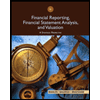
Connect 1 Semester Access Card for Fundamentals of Financial Accounting
5th Edition
ISBN: 9781259128547
Author: Fred Phillips Associate Professor, Robert Libby, Patricia Libby
Publisher: McGraw-Hill Education
expand_more
expand_more
format_list_bulleted
Textbook Question
Chapter 13, Problem 13.5PA
Interpreting Profitability, Liquidity, Solvency, and P/E Ratios
Coke and Pepsi are well-known international brands. Coca-Cola sells more than $46 billion worth of beverages each year while annual sales of Pepsi products exceed $66 billion. Compare the two companies as a potential investment based on the following ratios:
| Ratio | Coca-Cola | PepsiCo | |
| Gross profit percentage | 60.7% | 53.2% | |
| Net profit margin | 18.4% | 10.2% | |
| EPS | $1.90 | $4.32 | |
| Inventory turnover ratio | 5.3 | 8.2 | |
| 1.13 | 1.24 | ||
| Debt-to-assets | 0.41 | 0.38 | |
| P/E ratio | 20.4 | 19.3 | |
Required:
- 1. Which company appears more profitable? Describe the ratio(s) that you used to reach this decision.
- 2. Which company appears more liquid? Describe the ratio(s) that you used to reach this decision.
- 3. Which company appears more solvent? Describe the ratio(s) that you used to reach this decision.
- 4. Are the conclusions from your analyses in requirements 1–3 consistent with the value of the two companies, as suggested by their P/E ratios? If not, offer one explanation for any apparent inconsistency.
Expert Solution & Answer
Want to see the full answer?
Check out a sample textbook solution
Students have asked these similar questions
Can you solve this general accounting problem using appropriate accounting principles?
Which is not an objective of internal controls?A. Safeguard assetsB. Improve profitsC. Ensure accurate recordsD. Promote operational efficiency
no ai
Please provide the accurate answer to this financial accounting problem using appropriate methods.
Chapter 13 Solutions
Connect 1 Semester Access Card for Fundamentals of Financial Accounting
Ch. 13 - What is the general goal of trend analysis?Ch. 13 - Prob. 2QCh. 13 - What is ratio analysis? Why is it useful?Ch. 13 - What benchmarks are commonly used for interpreting...Ch. 13 - Prob. 5QCh. 13 - Prob. 6QCh. 13 - Slow Cellars current ratio increased from 1.2 to...Ch. 13 - From last year to this year, Colossal Companys...Ch. 13 - From last year to this year, Berry Bam reported...Ch. 13 - Explain whether the following situations, taken...
Ch. 13 - What are the two essential characteristics of...Ch. 13 - Prob. 12QCh. 13 - Prob. 13QCh. 13 - Prob. 14QCh. 13 - Prob. 15QCh. 13 - Prob. 16QCh. 13 - 1. Which of the following ratios is not used to...Ch. 13 - Prob. 2MCCh. 13 - Prob. 3MCCh. 13 - Analysts use ratios to a. Compare different...Ch. 13 - Which of the following ratios incorporates stock...Ch. 13 - Prob. 6MCCh. 13 - Prob. 7MCCh. 13 - A bank is least likely to use which of the...Ch. 13 - Prob. 9MCCh. 13 - (Supplement 13A) Which of the following items is...Ch. 13 - Calculations for Horizontal Analyses Using the...Ch. 13 - Calculations for Vertical Analyses Refer to M13-1....Ch. 13 - Interpreting Horizontal Analyses Refer to the...Ch. 13 - Interpreting Vertical Analyses Refer to the...Ch. 13 - Prob. 13.5MECh. 13 - Prob. 13.6MECh. 13 - Prob. 13.7MECh. 13 - Analyzing the Inventory Turnover Ratio A...Ch. 13 - Inferring Financial Information Using the Current...Ch. 13 - Prob. 13.10MECh. 13 - Identifying Relevant Ratios Identify the ratio...Ch. 13 - Prob. 13.12MECh. 13 - Analyzing the Impact of Accounting Alternatives...Ch. 13 - Describing the Effect of Accounting Decisions on...Ch. 13 - Prob. 13.1ECh. 13 - Prob. 13.2ECh. 13 - Prob. 13.3ECh. 13 - Computing Profitability Ratios Use the information...Ch. 13 - Prob. 13.5ECh. 13 - Matching Each Ratio with Its Computational Formula...Ch. 13 - Computing and Interpreting Selected Liquidity...Ch. 13 - Prob. 13.8ECh. 13 - Prob. 13.9ECh. 13 - Prob. 13.10ECh. 13 - Prob. 13.11ECh. 13 - Prob. 13.12ECh. 13 - Prob. 13.13ECh. 13 - Prob. 13.14ECh. 13 - Analyzing the Impact of Alternative Inventory...Ch. 13 - Prob. 13.1CPCh. 13 - Analyzing Comparative Financial Statements Using...Ch. 13 - Prob. 13.3CPCh. 13 - Prob. 13.4CPCh. 13 - Prob. 13.5CPCh. 13 - Prob. 13.6CPCh. 13 - Prob. 13.7CPCh. 13 - Prob. 13.1PACh. 13 - Analyzing Comparative Financial Statements Using...Ch. 13 - Prob. 13.3PACh. 13 - Prob. 13.4PACh. 13 - Interpreting Profitability, Liquidity, Solvency,...Ch. 13 - Using Ratios to Compare Loan Requests from Two...Ch. 13 - Prob. 13.7PACh. 13 - Prob. 13.1PBCh. 13 - Prob. 13.2PBCh. 13 - Prob. 13.3PBCh. 13 - Prob. 13.4PBCh. 13 - Interpreting Profitability, Liquidity, Solvency,...Ch. 13 - Using Ratios to Compare Loan Requests from Two...Ch. 13 - Prob. 13.7PBCh. 13 - Prob. 13.1SDCCh. 13 - Prob. 13.2SDCCh. 13 - Prob. 13.5SDCCh. 13 - Prob. 13.6SDCCh. 13 - Prob. 13.7SDCCh. 13 - Prob. 13.1CC
Knowledge Booster
Learn more about
Need a deep-dive on the concept behind this application? Look no further. Learn more about this topic, accounting and related others by exploring similar questions and additional content below.Similar questions
- Please provide the correct answer to this financial accounting problem using valid calculations.arrow_forward20 Nelson and Murdock, a law firm, sells $8,000,000 of four-year, 8% bonds priced to yield 6.6%. The bonds are dated January 1, 2026, but due to some regulatory hurdles are not issued until March 1, 2026. Interest is payable on January 1 and July 1 each year. The bonds sell for $8,388,175 plus accrued interest. In mid-June, Nelson and Murdock earns an unusually large fee of $11,000,000 for one of its cases. They use part of the proceeds to buy back the bonds in the open market on July 1, 2026 after the interest payment has been made. Nelson and Murdock pays a total of $8,456,234 to reacquire the bonds and retires them. Required1. The issuance of the bonds—assume that Nelson and Murdock has adopted a policy of crediting interest expense for the accrued interest on the date of sale.2. Payment of interest and related amortization on July 1, 2026.3. Reacquisition and retirement of the bonds.arrow_forward13 Which of the following is correct about the difference between basic earnings per share (EPS) and diluted earnings per share? Question 13 options: Basic EPS uses comprehensive income in its calculation, whereas diluted EPS does not. Basic EPS is not a required disclosure, whereas diluted EPS is required disclosure. Basic EPS uses total common shares outstanding, whereas diluted EPS uses the weighted-average number of common shares. Basic EPS is not adjusted for the potential dilutive effects of complex financial structures, whereas diluted EPS is adjusted.arrow_forward
- Which is not an objective of internal controls?A. Safeguard assetsB. Improve profitsC. Ensure accurate recordsD. Promote operational efficiencyarrow_forwardI need help finding the accurate solution to this general accounting problem with valid methods.arrow_forwardNelson and Murdock, a law firm, sells $8,000,000 of four-year, 8% bonds priced to yield 6.6%. The bonds are dated January 1, 2026, but due to some regulatory hurdles are not issued until March 1, 2026. Interest is payable on January 1 and July 1 each year. The bonds sell for $8,388,175 plus accrued interest. In mid-June, Nelson and Murdock earns an unusually large fee of $11,000,000 for one of its cases. They use part of the proceeds to buy back the bonds in the open market on July 1, 2026 after the interest payment has been made. Nelson and Murdock pays a total of $8,456,234 to reacquire the bonds and retires them. Required1. The issuance of the bonds—assume that Nelson and Murdock has adopted a policy of crediting interest expense for the accrued interest on the date of sale.2. Payment of interest and related amortization on July 1, 2026.3. Reacquisition and retirement of the bonds. Question 20 options: Paragrapharrow_forward
arrow_back_ios
SEE MORE QUESTIONS
arrow_forward_ios
Recommended textbooks for you
 Financial And Managerial AccountingAccountingISBN:9781337902663Author:WARREN, Carl S.Publisher:Cengage Learning,
Financial And Managerial AccountingAccountingISBN:9781337902663Author:WARREN, Carl S.Publisher:Cengage Learning, Managerial AccountingAccountingISBN:9781337912020Author:Carl Warren, Ph.d. Cma William B. TaylerPublisher:South-Western College Pub
Managerial AccountingAccountingISBN:9781337912020Author:Carl Warren, Ph.d. Cma William B. TaylerPublisher:South-Western College Pub EBK CONTEMPORARY FINANCIAL MANAGEMENTFinanceISBN:9781337514835Author:MOYERPublisher:CENGAGE LEARNING - CONSIGNMENT
EBK CONTEMPORARY FINANCIAL MANAGEMENTFinanceISBN:9781337514835Author:MOYERPublisher:CENGAGE LEARNING - CONSIGNMENT Financial Reporting, Financial Statement Analysis...FinanceISBN:9781285190907Author:James M. Wahlen, Stephen P. Baginski, Mark BradshawPublisher:Cengage Learning
Financial Reporting, Financial Statement Analysis...FinanceISBN:9781285190907Author:James M. Wahlen, Stephen P. Baginski, Mark BradshawPublisher:Cengage Learning


Financial And Managerial Accounting
Accounting
ISBN:9781337902663
Author:WARREN, Carl S.
Publisher:Cengage Learning,


Managerial Accounting
Accounting
ISBN:9781337912020
Author:Carl Warren, Ph.d. Cma William B. Tayler
Publisher:South-Western College Pub

EBK CONTEMPORARY FINANCIAL MANAGEMENT
Finance
ISBN:9781337514835
Author:MOYER
Publisher:CENGAGE LEARNING - CONSIGNMENT

Financial Reporting, Financial Statement Analysis...
Finance
ISBN:9781285190907
Author:James M. Wahlen, Stephen P. Baginski, Mark Bradshaw
Publisher:Cengage Learning
Profitability index; Author: The Finance Storyteller;https://www.youtube.com/watch?v=Md5ocNqKHq8;License: Standard Youtube License